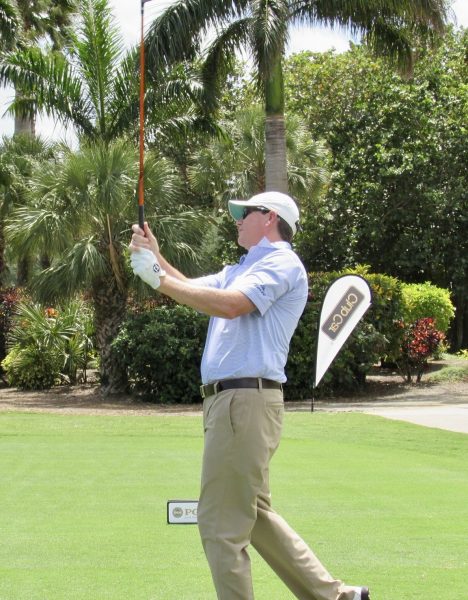By Eric Smith
Father’s Day coincides with the final round of this week’s U.S Open, making Sunday, June 17, a holy day of sorts for golfers. Not only is it the pinnacle of the professional season, but it is also the perfect time to buy dad a gift card for 18 holes at his favorite course.
But what if he doesn’t want to spend half a day on the links in the summer heat? Perhaps he’d rather hit balls at the driving range or in a simulator. Or maybe he just wants to spend a lazy weekend lounging around the house in a sharp new golf shirt while watching the world’s best battle it out on TV.
No matter how dad—or anyone else—wants to celebrate golf this week or throughout the year, the industry just wants to ensure they’re swinging a club, buying golf gear or otherwise soaking up some aspect of the game’s lifestyle.
In other words, golf insiders might argue, there are many paths to the same tee box.
In this first of a two-part series on the state of the golf industry, SGB looks at the sport’s participation levels and how associations, private companies, grassroots organizations and local course operators are working to ensure golf continues its current rebound by addressing the needs of core players while also attracting the next generation.
‘Solid And Evolving’
The reports of golf’s death are greatly exaggerated, according to most of the game’s stakeholders. Yes, participation numbers are down slightly and fewer courses are open, but most view golf as healthy—albeit a sport in transition.
“The way that I describe golf is that it is solid and it is evolving,” Steve Mona, CEO of the World Golf Foundation, told SGB.
A high-level look at golf’s participation numbers helps shed light on his divergent, two-word assessment. An estimated 23.8 million people played golf on a course in 2017, in line with 2016 and the second straight year of leveling off after a four-year decline from the 2012 total of 25.3 million players, according to the National Golf Foundation.
The latest numbers indicate the game has stabilized since the period that immediately followed the Great Recession, which crushed participation figures as fewer people had disposable income to join a club, buy new equipment or take golf vacations. Economic prosperity will always boost play, and the converse is also true.
And of the almost 24 million who played on a course last year, about 20 million are considered the game’s most committed golfers, those who account for about 95 percent of all rounds played and spending, according to NGF.
“I use the word solid to describe golf because that group’s not going anywhere,” Mona said. “They’re committed to the game. And they really drive the economics of the game.”
Golf rounds did decline 2.7 percent in 2017 to 456 million rounds, but that number is within the average weather-related fluctuation of 2 percent to 3 percent, according to NGF. Also according to NGF, the number of U.S. golf courses is down 6.9 percent from 2006, which followed a course-opening boom time—44 percent growth—from 1986 to 2005.
However, 14.5 million people “who don’t play the game at all are very interested in playing now, on a golf course,” Mona said. “Not when their kids graduate college, not when they get their next promotion, but now.
“The key, of course, is converting the interest into trial and then trial into commitment and that that’s kind of the way in which you get connected to the game,” Mona added. “You first develop an interest. Secondly, you try it and then third you become committed to it. It’s a process.”
But the process of growing the number of people who play golf on a course is only part of the picture. And this is where the evolving nature of golf lies. The number of people involved in an off-course form of golf—driving range, simulators, etc.—grew 7 percent last year to 21 million, according to NGF.
That adds to the total and provides a more promising outlook for the sport’s future. “Golf’s overall participation base—combining on-course golfers with the 8.3 million people who only played off-course—is now 32 million and continues to climb incrementally,” NGF wrote in the foundation’s 2018 Golf Industry Report.
And that excites folks like Mona who understand that this shift in how and where golf is played can benefit the industry.
“We’re seeing an evolution of golf participation where off-course participation, probably before too much longer, is going to be greater than on-course participation,” Mona said. “All those numbers make me very optimistic about the future of the game.”
The Future is Now
The biggest driver in golf’s off-course growth and the primary catalyst for the sport’s evolution is Topgolf, a Dallas-based company whose facilities are part driving range, part arcade, part party room, part restaurant and bar. The Topgolf experience is as much social gathering as golf outing.
The wildly popular venue now has 41 locations in the U.S. and U.K., with 23 more “coming soon” in the states as well as in Australia, Canada, Mexico and the United Arab Emirates, according to the company’s website. Topgolf draws millions of visitors each year and is growing those numbers exponentially, according to Ani Mehta, vice president of corporate development.
And the reason is simple. Learning how to drive or chip a golf ball is much easier in a Topgolf facility while enjoying an adult beverage with a small group of friends than at a course with dozens of strangers watching and waiting for the inevitable first-hole worm burner.
“Going to a traditional green grass golf course for a beginner is a very intimidating experience,” Mehta told SGB. “You’ve practiced a bunch on the range and you’ve taken lessons, but going up to the first tee for the first time is really tough.”
Not only that, but Topgolf is a fun, shared experience that lends itself well to birthday parties, Instagram posts and company meetings.
Topgolf’s reach is even greater than the company’s current footprint. Topgolf technology is being installed at non-Topgolf driving ranges around the world through Toptracer Range, Topgolf’s system that allows a regular driving range to give visitors the ability to track their drive distance and proximity to targets. They can now compare with their friends’ drives and even gauge how much they’re improving their own game.
“By adding technology to a very standard golf venue—a driving range that, in essence, has not changed—it enhances the experience for the end user; it enhances the performance of the range for the driving range owner,” Mehta said. “By adding technology, what you can do is now gamify the whole experience.”
Gamifying the golf experience is helping bring new people to the game, but Topgolf, NGF and WGF all believe this will also increase on-course play, as a gateway of sorts.
“We’ve done studies with the National Golf Foundation to understand the impact that Topgolf has on a moving people into traditional golf,” Mehta said. “A large number of people for whom the driver to get to a traditional golf course was going to Topgolf for the first time. Once you’ve tried golf on the driving range, it makes people more comfortable in taking those skills to the traditional golf courses.”
WGF’s Mona agrees, citing the 8 million people who only play off-course golf as within reach for transitioning to a course. “We view that number as a very fertile opportunity to convert people to the on-course experience,” he said. “Not all will, but we think a healthy number will.”
View from the Front Line
Ben Pittman, head golf professional at Estero Country Club at the Vines, just outside Fort Myers, FL, also believes more people will make their way from places like Topgolf to a traditional course.
Pittman, 46, is a latecomer to the sport who didn’t pick up golf until he was told it might help him create networking opportunities in his post-college sales career. He quickly discovered that not only did he love playing, but he was good at it, two factors that inspired him to eventually make a career change.
After toiling in sales for a few more years, Pittman decided to follow his passion and pursue a job in the industry. He enrolled in the San Diego Golf Academy’s campus in Myrtle Beach, SC, where he earned an associate degree in complex golf operations management—and “the rest, as they say, is history,” Pittman said.
Pittman lives and works where golf is a year-round, big business. He is on the sport’s front lines, so to speak, giving him a firsthand view of what’s happening with participation. Right now, he likes what he sees.
“I truly believe that golf is a game that has a sweet spot, and we are settling back into that sweet spot after some down years from the recession,” Pittman told SGB. “From my vantage point as a PGA professional, I tend to express it as more of a feeling. Working at a private club in Southwest Florida provides a unique perspective that may differ from what my colleagues have in different areas of the country, but from here the feeling I get is overwhelmingly positive, and much of that may have as much to do with people’s financial health as anything.”
He understands that baby boomers—the group that compose most of his club’s membership and most of the golf-playing population in Florida, as well as other places—are diehards. But he also understands that for the game to continue growing, it must extend its reach and attract millennials.
“Appealing to the next generation is crucial,” Pittman said. “Without them we can’t sustain the game, let alone grow it.”
Pittman credits Topgolf as a great way to introduce younger people to the sport and serve as a gateway to on-course play, but plenty of other factors can be a draw.
Not only is there “bound to be another golfer like Tiger Woods that will come along and inspire young people to want to be the next great golfer,” Pittman said, but junior golf initiatives and other player development programs can succeed in both attracting and retaining new players. The key is just getting a club in their hands, teaching them the mechanics and waiting for the allure of the sport to take over—an allure as old as golf itself.
“One thing that I know about everyone that ever plays the game, there is nothing like the feeling of hitting a great shot,” Pittman said. “If we can hit good shots more often, if we can play better and see our scores go down, the pull to the course to try and better our previous best is irresistible. Every segment of the industry can play a part in making sure that the next generation is exposed to that feeling. They may not join a country club, but they will always feel a desire to hit that shot just one more time.”
Preaching to the Unconverted
Numerous organizations, including the NGF, WGF and others, are working to introduce that feeling to anyone curious about or interested in the sport, each with campaigns detailed on their websites.
While initiatives might target different demographics, age groups or geographies, Mona said the WGF preaches the gospel of golf based on these four tenets:
1) Golf is fun. “That’s paramount,” Mona said. “Why else would you do something recreationally if you don’t perceive it to be fun? Through the years, not everyone has necessarily perceived golf that way, so we’re trying to make sure, first and foremost, that people understand it’s fun.”
2) Golf might be hard to play well, but it’s not hard to play. “People tend to equate the latter with the former, but I mean it isn’t really that hard to go out and swing at a golf ball with a golf club in your hand,” he said. “How well you hit it, how far you hit it and how straight you hit it—sure, that’s variable. We just try to get people off the notion that it’s a hard game.”
3) Golf is accessible. “It’s not expensive, though it’s perceived that way,” Mona said. “But 75 percent of the golf courses in the United States are open to the public and the average green fee across the United States is $34.”
4) Golf doesn’t have to take all day. “You can play golf in pretty much whatever segment of time you want,” Mona said. “You can, for instance, just hit balls on a driving range, you can go putt on a practice putting green, you can chip and hit bunker shots on the practice green environment, you could play nine holes and in some places you can play less than nine holes.”
WGF works with a number of programs, while many others, such as The First Tee, are working to grow the game among youth. Another organization, Nextgengolf, is working to promote the sport of golf by preventing early golf devotees from hanging up their clubs. Nextgengolf, whose motto is “Live Life. Play Golf,” works to ensure that juniors who grew up playing the sport and can’t play at the college level, or college players who can’t make the tour, continue to participate.
“What happens to those hundreds of thousands of golfers that don’t earn a college scholarship or go on to play professionally?” Kris Hart, CEO, Nextgengolf, asked SGB. “Through our NCCGA (National Collegiate Club Golf Association) and City Tour products, we cater to golfers in their 20s and 30s by proactively keeping golfers engaged through tournaments and bringing new players into the game.”
Hart said Nextgengolf will run 200 tournaments in 2018 for golfers aged 15-39, all under the mission of “supporting the rest, not necessarily just the best. Everyone is busy with life outside of golf, but we give people a reason to get out on the course and play.”
From the highest levels of the sport down to the grassroots, everyone in the sport has a role to play. Stakeholders across the country—no matter the region, no matter if they work for public or private courses, no matter if they manage a Topgolf or run a youth golf nonprofit—are uniting in their quest to promote the game’s time-honored traditions with newfangled technology to ensure it remains solid while continually evolving.
“My role at a private, member-owned club in Southwest Florida is going to be drastically different than someone at a daily fee course in the Midwest,” Pittman said. “My role may be more retention (through player development, member recruitment, etc.), whereas someone in a different area may be more growth-oriented, trying to attract juniors, women, minorities to pick up the game.
“The golf industry is huge, and we all play a small but different role—none of which is more important than another.”
In part 2, SGB will examine the current state of retail sales and how golf hardgoods and softgoods manufacturers are faring.
Photos courtesy Topgolf, Ben Pittman, The First Tee
[author] [author_image timthumb=’on’]https://s.gravatar.com/avatar/dec6c8d990a5a173d9ae43e334e44145?s=80[/author_image] [author_info]Eric Smith is Senior Business Editor at SGB Media. Reach him at eric@sgbonline.com or 303-578-7008. Follow on Twitter or connect on LinkedIn.[/author_info] [/author]



















